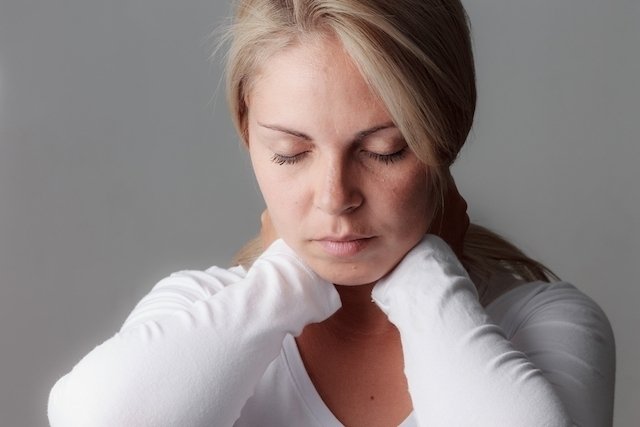Pain throughout the body can be diverse and may be associated with stress, anxiety or be a consequence of infectious or inflammatory processes, such as flu, dengue fever or fibromyalgia, for example.
As body pain can be indicative of more serious causes, it is important to assess whether the pain is accompanied by other signs and symptoms, such as fever, headache, cough or joint stiffness.
If signs and symptoms other than body pain are identified, if the body pain is very intense or if it does not improve after a few days, it is recommended to consult a general practitioner to identify the cause and begin the most appropriate treatment.

7 common causes of body pain
The most common causes of pain throughout the body are:
1. Stress and anxiety
Stress and anxiety can lead to excess tension, which can make the muscles stiffer and can lead to pain throughout the body, mainly noticed at the end of the day in the neck, shoulders and back.
What to do: It is important to focus on strategies that help you relax throughout the day, preventing tension and body pain. Therefore, it is recommended to rest and practice relaxing activities or activities that promote a feeling of well-being, such as meditation, yoga, walking or dancing, for example. Check out some ways to relieve stress and anxiety.
2. Sleeping in the wrong position
An inappropriate position when sleeping can lead to body pain the next day, because depending on the position in which you sleep, there may be overload on your joints, especially your spine, leading to pain.
In addition to the sleeping position, the quality of sleep can also favor the appearance of pain in the body, as in the case of short sleep, there may not be enough time to regenerate and, therefore, it does not have the necessary energy to function properly. When this happens, it is common to begin to feel a general feeling of discomfort that worsens and causes pain throughout the body.
What to do: To avoid pain, it is recommended to pay attention to the position in which you sleep, as this will help avoid overloading your joints. Furthermore, the position can also promote an improvement in sleep quality. See what the best sleeping positions are.
3. Flu or cold
Flu and colds are frequent causes of body pain, which is usually accompanied by a feeling of heaviness in the body, general malaise, runny nose, headache and fever.
Although these diseases are more common in winter, they can also occur in summer, and the pain in the body can be more intense due to dehydration of the body caused by the higher temperature of the environment.
What to do: In these cases, it is important to rest at home, drink at least 1.5 liters of water per day and have a healthy and balanced diet. In some cases, the doctor may also recommend the use of medications such as Paracetamol or Ibuprofen to help relieve symptoms. Check out some home remedy options for the flu.
4. Physical activity
Physical activity can also lead to the appearance of pain throughout the body, occurring more frequently in people who are sedentary, who have not performed physical activity for a period of time, who have changed the type of training or performed more intense training. This triggers a local inflammatory process, as well as the production of enzymes and substances by the body as a result of exercise that ultimately lead to the onset of pain.
What to do: When pain in the body is due to physical activity, in addition to resting, it is important to continue exercising, as this will allow the muscles to get used to it little by little and thus avoid muscle pain. If the pain is very intense and prevents you from carrying out simple daily activities, your doctor may recommend the use of anti-inflammatories. See how to combat muscle pain.
5. Arthritis
Arthritis is an inflammation of the joint that leads to pain, stiffness and difficulty moving the joints involved and can occur in people of all ages, being more common in people over 40 years of age.
What to do: Treatment for arthritis must be guided by a rheumatologist, and the use of medications is normally recommended to reduce inflammation and symptoms, in addition to physiotherapy sessions and, in more serious cases, surgery.
6. Fibromyalgia
Fibromyalgia is characterized by the presence of pain in some specific points of the body, which gives the impression that there is pain throughout the body. These pains are usually worse in the morning and especially affect women.
What to do: It is recommended to consult a rheumatologist if fibromyalgia is suspected, as this makes it possible to evaluate the symptoms presented and begin appropriate treatment, which is normally done with medication and exercises guided by a physiotherapist. Understand more about the treatment for fibromyalgia.
7. Dengue, Zika and Chikungunya
Dengue, Zika and Chikungunya are diseases caused by different viruses that can be transmitted by the same insect, which is the Aedes aegypti mosquito. These diseases have very similar characteristics, with all of them experiencing pain in the body and joints.
What to do: If you suspect Dengue, Zika or Chikungunya, it is important that you consult a doctor so that symptoms can be assessed and tests can be carried out to help differentiate the three diseases, so that the most appropriate treatment can then be started, which normally involves rest and good hydration. See how to know if it is Dengue, Zika and Chikungunya.
When to go to the doctor
It is important to consult a general practitioner, rheumatologist or physiotherapist when body pain does not improve after 3 days and is accompanied by other signs and symptoms, such as persistent fever, very intense pain that makes movement difficult, nausea, vomiting, fainting, night sweats , unexplained weight loss and difficulty breathing.
Taking care of your health has never been easier!
After evaluating the symptoms and pain, the doctor can identify the cause of the pain and thus recommend the most appropriate treatment.

Sign up for our newsletter and stay up to date with exclusive news
that can transform your routine!
Warning: Undefined array key "title" in /home/storelat/public_html/wp-content/plugins/link-whisper-premium/templates/frontend/related-posts.php on line 12
Warning: Undefined array key "title_tag" in /home/storelat/public_html/wp-content/plugins/link-whisper-premium/templates/frontend/related-posts.php on line 13



